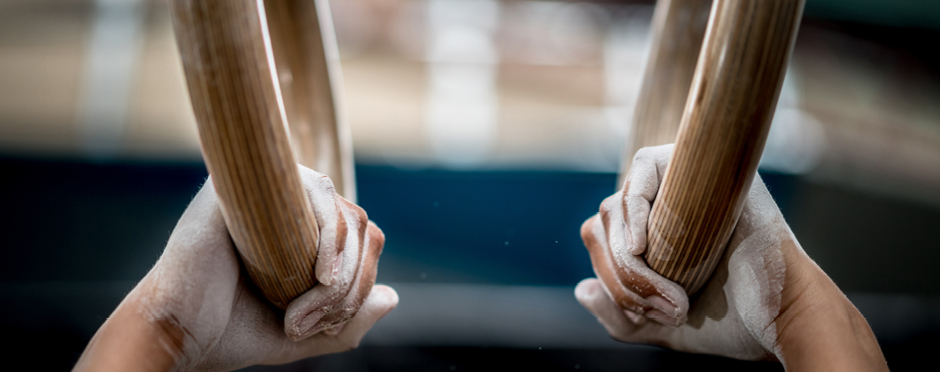
Wrist Pain in Gymnasts and Cheerleaders
Comments Off on Wrist Pain in Gymnasts and CheerleadersThe gymnastics and cheer seasons’ are picking up intensity! Check out our first of two blogs focusing on staying healthy during the gymnastics and cheerleading season. Our first blog by Sarah Clough PT, DPT, Cert. MDT, PES, who has a passion for treating gymnasts, trampolinists and cheerleaders, focuses on wrist pain in gymnasts and cheerleaders.
Think about the amount of pressure your wrists experience during a Yurchenko vault, a series of flip-flops or basing that 110lb flyer in a cupie above your head with one arm? Studies show that the amount of weight placed through the wrists in the sport of gymnastics varies between 2 times to 20 times an athlete’s body weight. That is a lot of pressure through a very tiny joint in the body!
Think about your wrists helping to hold you up during a handstand contest. All of your body is balancing on your arms and those wrists take a lot of stress. Conditioning and stretching routines often focus on building the core, keeping the legs flexible and building up that leg strength. Are you remembering to take care of your wrists? Here are some good reminders of ways to help prevent wrist problems for gymnasts and cheereladers!
-
Stretch Your Wrists:

 In order to perform at the maximum level as a gymnast or cheerleader, your wrists have to bend backwards almost to a 90 degree angle. On top of that, all of your weight, or someone else’s weight, is bearing through that area. Surprisingly, a majority of gymnasts and cheerleaders I check for wrist flexibility lack some motion at the wrist. That lack of flexibility may increase the potential for injury. Remember to stretch both the front and back of your wrists. Perform stretches with your elbows bent and with them straight.
In order to perform at the maximum level as a gymnast or cheerleader, your wrists have to bend backwards almost to a 90 degree angle. On top of that, all of your weight, or someone else’s weight, is bearing through that area. Surprisingly, a majority of gymnasts and cheerleaders I check for wrist flexibility lack some motion at the wrist. That lack of flexibility may increase the potential for injury. Remember to stretch both the front and back of your wrists. Perform stretches with your elbows bent and with them straight. -
Strengthen Your Wrists:
Increasing the strength of the muscles surrounding a joint, helps protect that joint from
 injury and keep it stable. Strengthening your wrists during practice is one of the easiest things that can be implemented, but is often missing from the gym routine. How often do you stand around waiting for your turn on the vault run-way? Grab a light weight, theraband or even your water-bottle while waiting your turn at practice and start working on those wrists!
injury and keep it stable. Strengthening your wrists during practice is one of the easiest things that can be implemented, but is often missing from the gym routine. How often do you stand around waiting for your turn on the vault run-way? Grab a light weight, theraband or even your water-bottle while waiting your turn at practice and start working on those wrists! -
What About Taping Or Using Wrist Guards?
If you are taping your wrists at every practice because you are having pain: a) You may want to get a complimentary injury screen from Athletico or have your doctor check your wrists out. b) Tape is not a substitute for strengthening and stretching and should be temporary. Wrist guards are great for gymnasts. Wrist guards can often redistribute pressure on the wrist by providing padding and allowing you to tumble effectively with a less stress on the wrist. Tiger Paws or the EZY ProBrace wrist guards are commonly used.
-
Have Any Pain Checked Out:
Aside from the daily impact your wrists may have from tumbling and stunting, many reasons exist as to why wrist pain is not improving in a gymnast or cheerleader. Different types of injuries can occur at the wrists and may need a medical recommendation. Injuries may occur form repetition over time. Continuing to tumble on a wrist or wrists that are in pain, especially if they are getting worse, may lead to an injury that results in time out of the sport or the inability to place your body weight through your wrists for a long time. The sooner you get those wrists checked out, the faster you may be able to get back to the gym.
Though many of us prefer to be upside down at all times, we are built to walk on our feet and not on our hands. So if you prefer to be upside down or love holding your stunting partner above your head for minutes at a time, take care of those wrists! You will perform better and feel better because you do!
For more information on Athletico’s Gymnastics Rehabilitation program, please click here. To request a free assessment at any of our locations, click the button below.
The Athletico blog is an educational resource written by Athletico employees. Athletico bloggers are licensed professionals who abide by the code of ethics outlined by their respective professional associations. The content published in blog posts represents the opinion of the individual author based on their expertise and experience. The content provided in this blog is for informational purposes only, does not constitute medical advice and should not be relied on for making personal health decisions.

Comments are closed